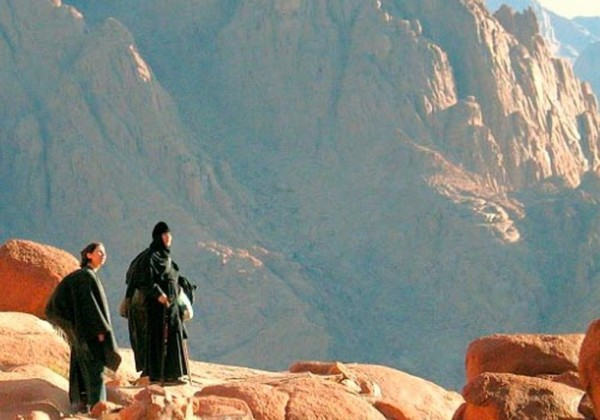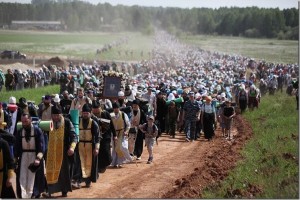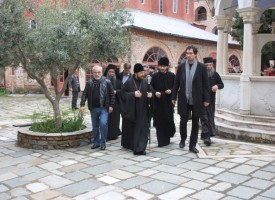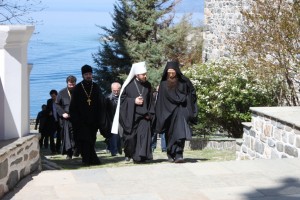Pilgrimages to sacred and holy places were not invented by Christians. In fact, we most likely inherited this practice from the traditional Greco-Roman culture, in which sacred trips to oracles and special places were not something strange or unknown. At the same time, the debate about the necessity and profit of such pilgrimages – understood early on mainly in terms of visiting the sites associated with the Earthly life of the Savior – was present in the Church from the very early centuries. We can find citations in the writing of respectable Fathers of the Church in favour of such earthly-tied spiritual journeys; there were, on the other hand, some Holy Fathers who were critical of journeys to the places of the “glory revealed,” and almost condemned them as something unessential and irrelevant. However, from the historical perspective, we can say that the overwhelming attitude of Christians toward pilgrimages was positive. A number of classic Christian writings of Late Antiquity that deal with relationship of pious, ascetic and hagiographical material link very closely to the “journeys of faith”, and in one form or another are associated with the “memory of the eyes”. In the later, Medieval period, pilgrimages became a prominent and noble thing both in the East and in the West; the practice brought together the whole spectrum of society, as peasant simpletons to royal monarchs participated in pilgrimages. There is a debate about pilgrimage in the modern world as well. As always, we can find zealous supporters and adamant opponents of such ventures, but in this article, I’d like to reflect on our religious environment in application to the given theme and some other subjects that in my mind can be closely linked to a modern day pilgrimage and that under the circumstances can make them even more necessary and beneficial.
In the new reality of the post-Christian world, where the Christian population finds itself increasingly in the minority and overall church attendance is dramatically decreasing across all of the traditional Christian denominations, people who truly care about the well-being and the very existence of the Church are compelled to take some kind of measures in an attempt to change the situation.
For more and more of our parishioners, participation in the life of the Church becomes not a “chore” but a sacrifice. It is apparent that in a few short years in the vast majority of the Orthodox parishes in North America, parishioners will be converts of one sort or the other. Among them there will be fewer and fewer people who were brought up in the Church and for whom church attendance is not merely a matter of habit, or part of the traditional way of life.
Under such circumstances, where church attendance is still a novelty to a degree, it is very apparent that higher education on matters of church life is greatly needed, along with the cultivation of a traditional sense of piety among the faithful. While able to access all sorts of theological literature and famous Orthodox and traditional Christian lecturers via books and the Internet, most of our parishioners, especially those who join the church from the various Protestant denominations, are still lacking exposure to the traditional ways and appearances of an environment that has been shaped by the forms of traditional Eastern Christianity. Striving to define the unique manifestation of North American Orthodoxy, we observe that many of our new members have only a very vague idea of what the traditional forms of Christianity are, and what type of art, architecture, music and liturgical forms it has produced. The absence of all the above in the surrounding environment leads to the delusional opinion (to my mind) that tradition and form can be established in total separation from the already existing forms and on the basis of a very shallow understanding of them.
We see, for example, a revival of iconography, but we hardly see any adequate works of religious art. We see some new churches built, but some of them lack even a very basic understanding of sacred space and resemble commercial or fast food buildings more than an Orthodox Church. Having accepted the premise that we are very different, we do not encourage and do not understand pilgrimages overseas – and yet we try to establish a new tradition of religious gatherings in the form of commissions, retreats, etc. We see the gradual substitution of the traditional historical forms of Orthodox Christianity – forms that have been proven by the spiritual practice of both East and West – with something new that is at times described as “American Orthodoxy”, but that rather appears to be Protestant or even diluted secularized Orthodoxy.
Under such circumstances, pilgrimages and various religious trips can serve in multiple and very practical ways. Religious-historical pilgrimages provide people with an opportunity to travel to places of great historical importance and to pray and worship at the ancient and Orthodox Holy Shrines. It is obvious that despite general economic hardship, a lot of our fellow citizens (and many Orthodox among them) travel extensively. While many of them may prefer vacations in the South Seas, there are many who do travel to Europe. Use of the general tourist agencies may provide first class service, but lacks anything that will even remotely inspire or promote the religious or spiritual aspect of life. Most of the tour guides, even in countries that are rich with Christian artifacts and holy sites, are totally ignorant or are in any case incapable of providing adequate information to an inquirer. Religious and historical pilgrimages that are conducted by a well-prepared guide and include the possible presence of Orthodox clergy can provide people with the opportunity not only to interact with the local believers, but also to pray, to confess, and to worship at the holy sites in their own language. The educational aspect of a pilgrimage can be even broader. Such pilgrimages may have a different theme, where the destination is defined and the number of places to visit is limited. Emphasis at that point would be on a precise festal event and some specific educational activity. Modern-day pilgrimage can serve as an opportunity for true ecumenical engagement and witness. As it is well known, there are certain groups who are interested in Early Church and Eastern Christian traditions and spirituality. There are people of various Christian denominations who seek a better understanding of the wealth of the Orthodox heritage, especially in the light of their personal attempt to find themselves and redefine their place in Church life.
The traditional historical element in the life of the Church is not only about the much-discussed subject of continuity. It is also something that serves as a silent external (that is, to the world) and internal (that is, to us, the present members of the Church) mission. We proclaim the Gospel, and yet in some shape or form in an everyday reality we seek the inspiration and renewal in our own inheritance, not into largely irrelevant forms or rituals, but in the very tradition and form shaped and produced by the experience and labour of generations of our faithful predecessors. At some point they were learning in order to put something forth. In the same fashion, we will leave some legacy too, and it will be much more wonderful if we ourselves become true inspirations and “memories of the eyes” to our contemporaries and for those who will come after us.
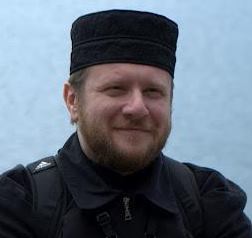 Father Ilya Gotlinsky is priest of Dormition of the Virgin Mary Church in Binghamton, New York. He has led numerous pilgrimages to Orthodox holy sites around the world, and can be reached through www.orthodoxtours.com.
Father Ilya Gotlinsky is priest of Dormition of the Virgin Mary Church in Binghamton, New York. He has led numerous pilgrimages to Orthodox holy sites around the world, and can be reached through www.orthodoxtours.com.












